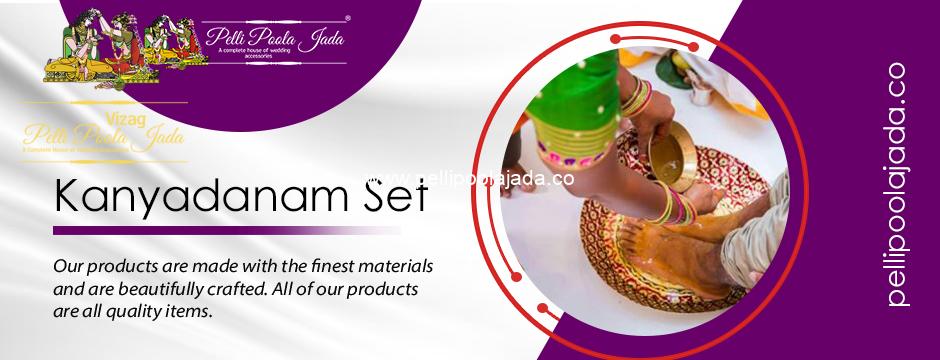Each area of India has its own distinct traditions and customs that are exclusive to that area. Despite this, there are many ways in which Telugu marriage is comparable to Tamil marriage. Telugu wedding ceremonies have a distinctive heritage in that they place equal emphasis on spirituality and religion. Telugu marriages aren’t considered complete unless women take part in the rituals. Where women are taken into account in family life and marriages, they are treated with the utmost care and regard.
See out some of the spiritual traditions that make Telugu weddings so incredibly holy, enchanted, and pure!
Muhurtham
A priest and the senior members of the family decide on the wedding’s auspicious date during the Muhurtham rite. The fact that Telugu marriages often do not take place during the months of Shunya, Asad, and Bhadrapad is important to notice.
Pelli Godugu
The Haldi ceremony that is conducted in the Northern states and this rite is extremely similar. The bride and the husband are both covered with a paste composed of turmeric and oil during this wedding rite. Each of them must take a full bath before donning clean, new clothing. Fresh flowers are typically used to embellish the bride’s hair. Pelli Godugu is used in the traditional Telegu wedding.
Snathakam
Snathakam rituals are typically performed at the bridegroom’s home. The groom is required to wear a silver sacred thread throughout this ritual. This indicates that he has transitioned from being a bachelor to a householder.
Kashi Yatra
Similar to the Tamil wedding tradition, the Kashi Yatra is performed at Telugu marriages. The groom essentially acts as though he is leaving for Kashi as a celibate throughout this rite. When this happens, the bride’s brother intervenes to stop him and implores him to change his mind and wed his sister. Naturally, the groom finally persuades his bride to accept to the marriage.

Mangala Snanam
At the wedding ceremony known as Mangala Snanam, the bride and groom are required to take a cleansing holy bath before attending an Aarti. Both the bride and the groom must go through this purification procedure in order for them to be prepared to participate in the religious rituals.
Ganesha and Gauri Puja
The bride does the Gauri puja at her home, and the husband performs the Ganesh puja at the wedding location. The bride prays to the goddess Gauri, who represents fertility and motherhood, and asks for a connection that is as perfect as the one the goddess has with her husband, Lord Shiva. The groom conducts the Ganesh Puja before the bride approaches the Mandapam (the platform or stage where the wedding is performed). In the Hindu religion, a Ganesh Pooja is performed before every auspicious event since Lord Ganesha is thought to remove all barriers. As a result, the Ganesh puja is the first ceremony to take place in the Mandapam. Opt for Ungarala Bindi today for the rituals.
Bride’s and Groom’s Entry & Terasala
A curtain known as the Addutera or Terasala (‘tera’ meaning screen) is placed between the bride and groom since they are not allowed to gaze at each other until the Jeelakara Bellam rite is complete.
Kanyadanam and Panigrahanam
Kanyadanam means “giving away of the bride” (from the Sanskrit words “dan” for giving away or donation and “Kanya” for young girl). The bride’s family formally offers her hand to the groom at this ritual. The bride’s parents first wash the groom’s feet because they believe the person to be Lord Vishnu’s incarnation and that he has come to wed their daughter, who is revered as the goddess Lakshmi.
The bride’s parents give their daughter away as clarinet music called “sannai mellam” and chanting of holy mantras are playing in the background. Hinduism views “Kanyadanam” as one of the most honourable deeds a parent can do. The groom is then requested to vow to the bride’s parents that he would stay by her side through thick and thin by holding her hand, a tradition known as “panigrahanam”. Buy Kanyadanam Set from Pelli Poola Jada Online.
JeelaKarra Bellam or Sumuhrutham
This is the Telugu wedding’s major attraction. In Telugu, “Jeelakara” signifies cumin and “Bellam” indicates jaggery. A paste made of cumin and jaggery is applied to the couple’s hands to begin the procedure. The pair moves their hands over the curtain and applies this paste to each other’s heads at the exact Sumuhrutham. The curtain that had previously divided them is now gone as the pair is presently legally married. The jaggery and cumin paste is a sign that the pair will be together through both the happy and sad times in life. By putting the paste on each other’s heads, it is also supposed that the pair exchanges ideas and destiny, connecting their lives.

Madhuparakam
The bride and groom depart for their apartments following the Jeelakara-Bellam and change into their “Madhuparakam” attire. Essentially, these Madhuparakam are white garments with a red, yellow, or green border. The red, yellow, and green colours represent power, which is a necessary quality in every marriage, while the white hue stands for purity or fidelity. The bride and groom change into their new attire and then head back to the Mandapam for the further rites.
Mangal Sutra Dharana
The Mangalsutram or thaali, a holy yellow thread covered in turmeric and adorned with two distinct gold pendants known as “sutralu,” is put around the bride’s neck by the husband in three knots while fast-paced music called “sannai mellam” plays in the background (shehnai). The three knots represent the bridegroom’s pledge to accept her as his wife through three channels: Manasa (thoughts), Vacha (speech), and Karmana (activity) (actions). The ceremony represents the couple’s whole union—spiritually, psychologically, and physically. In practically all of India’s states, a married lady may be recognised by her mangalsutram, or necklace. On the sixteenth day after the wedding, the yellow thread is changed for a gold chain.
Talambralu
This is the exciting portion of the wedding that the couple and their family may enjoy together. The bride and groom pour “Navaratna Talambralu” on each other’s heads in this tradition, simulating a shower. The first three times, the pair correctly showers each other with “Talambralu,” but thereafter, it turns into a contest to see who can pour more. Currently, the rice also contains additional items like rose petals, pearls, and vibrant thermocol balls. In the spirit of the game, the friends, and family members gather on the couple’s respective sides and hold them back while one person tries to pour. This celebration causes a lot of laughing and satisfaction all around and represents the marriage’s happiness and success.
Dandalu – Exchange of Garlands
The bride and groom exchange garlands after Talambralu as a sign of their acceptance as couples.
Sthalipakam & Nalla Pusalu
In this custom, the bride’s maternal uncle puts a silver toe ring on her second toe. The bride is then given a necklace made of gold and black beads, known as a “Nalla pusalu” in Telugu, by the groom. The purpose of nalla pusalu is to protect the bride from the evil eye’s negative consequences. Similar to how wedding rings in Western nations identify married women, the mangalsutram, silver toe ring, and nalla pusalu do the same in India. So married ladies in India wear them every day.
In addition to its cultural importance, toe rings provide health advantages. Toe rings, according to Ayurveda, control the menstrual cycle, improving the likelihood of pregnancy. Moreover, the pressure put on the second toe when walking reduces discomfort experienced during sexual activity.

Saptapadi
Together, the words “sapta” and “padi” stand for seven and steps, respectively (seven steps). Several regions do this ceremony differently. The bride and groom take seven paces around the holy fire in various cultures (homam). The bride takes the lead in the next four rounds after the husband leads the first three. In accordance with our custom, the bride must touch seven betel nuts while clasping the groom’s hands. Finally, to symbolise equality in the marriage, the bride, and the husband three times touch their toes together. The seven steps stand for the seven marital vows.
- To nourish each other.
- To grow together in strength.
- To preserve our wealth.
- To share our joys and sorrows.
- To care for our joys and sorrows.
- To care for our children and parents.
- To remain friends lifelong.
Brahma Mudi
Following Talambralu and Dandalu, Brahma Mudi is performed, in which loose ends of the bride’s saree and the groom’s Kanduva are knotted with a set of betel nuts, dried dates, turmeric twigs, betel leaves, and some money coins (Shawl). The bride and groom should preserve excellent relationships with both of their respective families, according to the Brahma Mudi, which is the name of the knot that joins the bride’s and groom’s knots.
The Ring Game
The “finding the ring” ceremony is the most enjoyable Telugu wedding tradition. Two rings—one gold and one silver—are dropped into the water pot as part of this rite. To see who would choose the gold ring first, the bride and groom each extended their right arm into the air. It is the best of the three series, and the winner is thought to have the upper hand in the marriage if they locate the gold ring twice. As they support their teams, the family enjoy this rite just as much.
Arundhati Nakshatram
The priest leads the couple outside the Mandapam during this procedure, so they may see the Arundhati and Vasistha Nakshatram (star) in the sky. The bride is shown the stars by the husband. Given that they are a role model couple, Vasistha and Arundhati are cited as an example.
Appagintalu
The last Telugu wedding ritual, known as Appaginthalu, sees the bride’s family formally handing her over to the groom’s family. The bride departs the Mandapam with the husband to his house following the procedure. For the bride and her family, this is typically the most emotional part of the ceremony.
Telugu weddings, in short, have a highly rich custom and ceremony. In Telugu weddings, worshipping and praying are given the utmost priority. Telugu weddings, in short, have a highly rich custom and ceremony. In Telugu weddings, worshipping and praying are given the utmost priority. Refer to the online matrimony services if you enjoy this culture and are seeking for a Telugu life mate. There are several matrimonial websites with various choices and filters that may help you focus your search for the ideal match.

